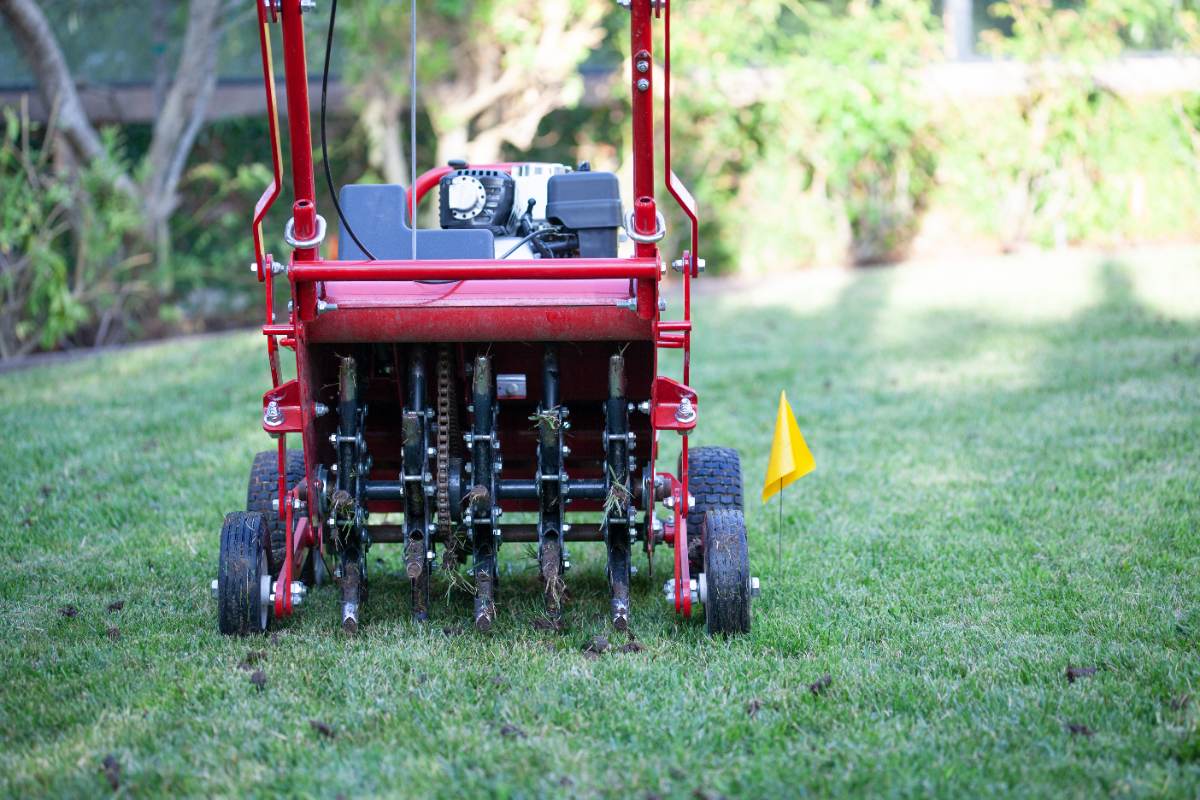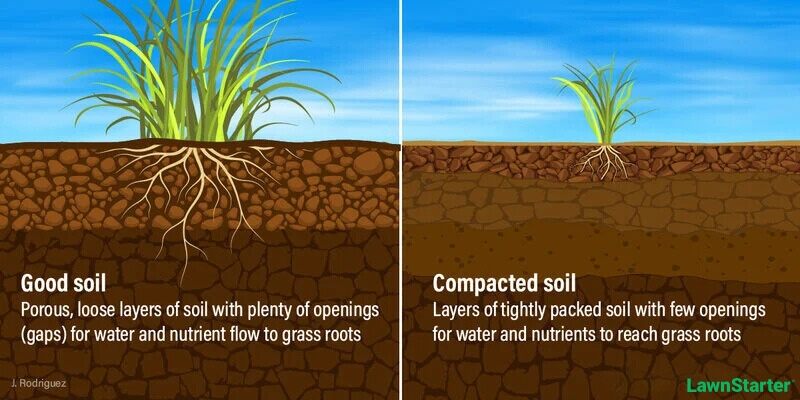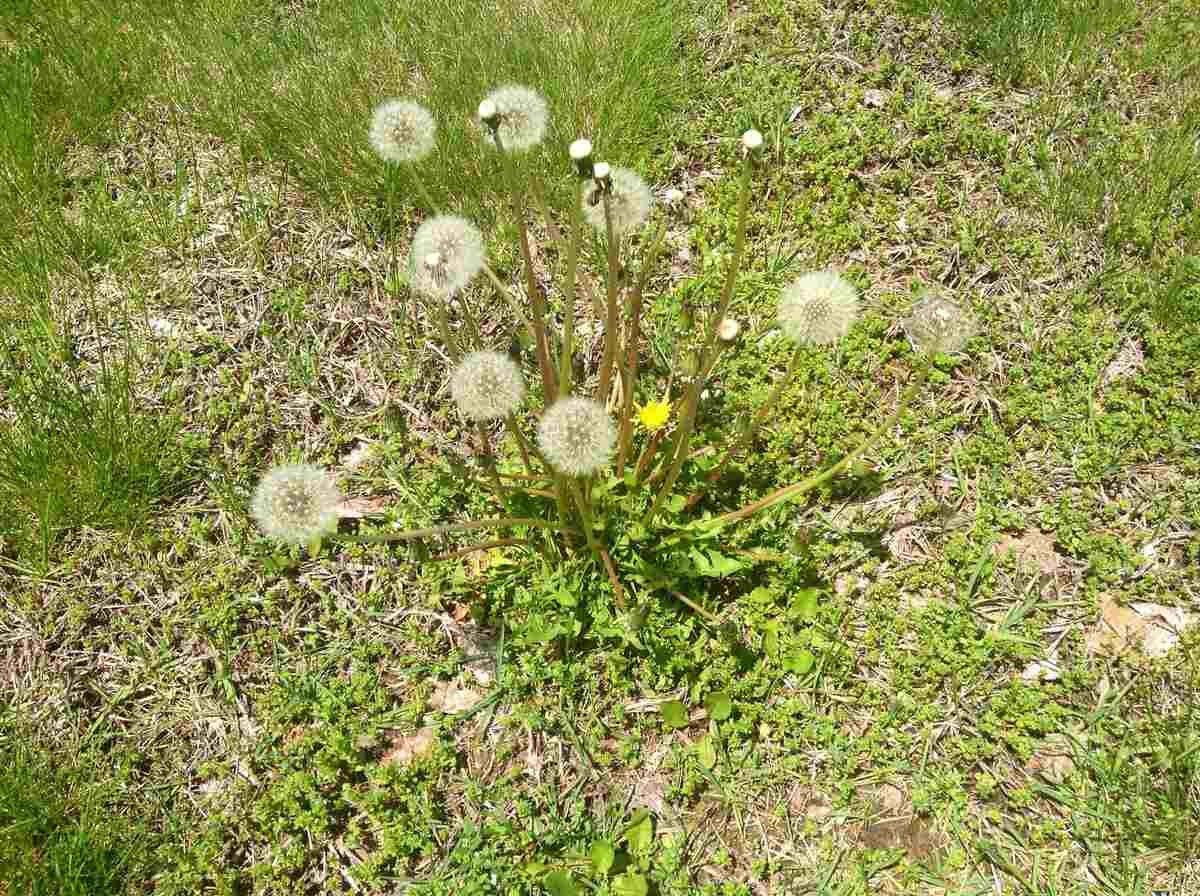
Your lawn may look healthy, but soil compaction and thatch buildup can cause hidden stress. That’s one major reason why you should aerate your lawn — to help it breathe, absorb nutrients, and grow stronger.
Aeration is a key lawn care task that you should perform every year. We’ve asked an expert to help explain the importance of aeration in enhancing water absorption, stimulating root growth, and maintaining a lawn’s health and green appearance.
Improves Water Absorption
If your lawn has compacted soil, water will just run off the surface instead of soaking in. By creating holes into the soil, aeration solves this problem, allowing water to reach deep into the root zone where it’s most needed.
So, if you notice your yard turning into a mini lake after watering, that’s a clear sign your soil needs some breathing room. Here’s how aerating your lawn can help it absorb water more efficiently:
- Prevents water runoff: Instead of pooling on the surface, water can now seep directly into the soil.
- Reduces dry spots: Your lawn will be hydrated evenly, including the dry patches caused by poor water absorption.
- Maximizes irrigation: You’ll get more out of each watering session, which is great if you’re trying to conserve water.
With improved water absorption, your lawn will be more resilient even during a drought.
| For help aerating your lawn, you can hire a LawnStarter aeration pro. You can even bundle aeration with overseeding for around $362. Last year, our pros performed around 245 aeration and overseeding services, which our customers gave an average rating of 4.1. |
Enhances Nutrient Uptake

You can fertilize your lawn effectively only if those nutrients actually reach the roots. If your soil is compacted, nutrients tend to sit near the surface where they can’t do much good. By fixing compacted soil with aeration, you’re opening up the soil, allowing essential nutrients to travel deeper into the root zone.
Here’s how aeration boosts nutrient absorption:
- Improves fertilizer effectiveness: Nutrients like nitrogen, phosphorus, and potassium can reach the root zone more easily and effectively.
- Strengthens turf from within: Well-fed roots grow thicker, helping your lawn recover from heat, foot traffic, and other stressors.
- Boosts microbial activity: Healthier soil promotes beneficial microorganisms that help break down organic matter.
| LawnStarter pros also do lawn fertilization services, which cost an average of $103 per service. They completed almost 40,000 lawn fertilization jobs last year, and our customers gave them an average rating of 4.4. |
Develops Stronger Roots
A healthy lawn starts below the surface. Aeration gives your grass roots the space and access they need to grow deep and strong. Without it, roots can become shallow and weak, leaving your lawn vulnerable to drought, common pests, and diseases.
Aeration helps develop stronger root systems, as it:
- Encourages deeper root growth: Looser soil allows roots to grow deeper into the soil.
- Improves lawn resilience: Strong roots help your grass recover more quickly from lawn stress, such as heavy foot traffic or heat waves.
- Supports long-term health: A deeper root system leads to a thicker, greener, and more self-sufficient lawn over time.
See Related: Best Grasses for High-Traffic Yards
Reduces Soil Compaction

Many homeowners enjoy walking barefoot on grass, as it can help lower stress and improve sleep. But it’s not fun if the lawn has compacted soil. So, if your lawn feels hard underfoot or struggles to grow despite regular care, aeration might be the answer.
Compacted soil squeezes out air pockets that grass roots need to breathe and grow. According to Timothy Ripp, horticulture educator at the University of Wisconsin-Madison, “Compaction also impacts the ability of the plants to uptake nutrients because the available nutrients are essentially locked together and cannot easily move through the soil’s structure.”
Aeration can give your lawn room to thrive:
- Restores airflow to the soil: Roots get the oxygen they need to function properly and stay healthy.
- Makes it easier for water and nutrients to penetrate: Instead of just pooling or bouncing off the surface, they sink in where they’re needed most.
- Creates a better growing environment: Since aerated soil helps promote stronger root development, it can improve overall lawn health.
Expert Tip: Topdressing your lawn after aeration can be more effective at relieving soil compaction. Instead of just leaving the aerated holes open, fill them with nutrient-rich material like compost to help improve soil structure.
See Related:
Controls Thatch
The right amount of thatch (a layer of dead and living organic matter) can be helpful to your lawn. But too much thatch can block water, air, and nutrients from reaching the roots, which is why Ripp warns against letting thatch accumulate. According to him, if the thatch is more than 1/2 to 3/4 inches thick, it can prevent water from absorbing into the soil.
For a thin layer (less than 1/2 inch) of thatch, aeration can help promote decomposition by allowing more oxygen to enter the soil and boost microbial activity. In turn, microbes can digest and decompose excess thatch and keep it under control.
If the thatch on your lawn is already around 1/2 inch thick or more, you’ll want to dethatch your lawn instead. It’s best to do it in late spring to early summer for warm-season grasses. For cool-season grasses, perform it in early spring or early fall.
Controls Weeds

Weeds love weakened lawns. And grass suffering from compacted soil or shallow roots can leave openings for weeds to move in and take over.
If you find weed control too stressful, don’t skip aeration — it can make it harder for the weeds to invade your yard in the first place:
- Strengthens turf density: A thicker lawn can help crowd out weed seeds and limit their access to sunlight and space.
- Promotes deeper roots: Healthy roots can create a strong foundation to help your grass outcompete weeds.
- Improves nutrient distribution: Allowing your grass to absorb nutrients can make it more resistant to weed invasion.
“Aeration alone will not magically make your weeds disappear,” says Ripp, “but by improving soils, you will naturally promote a thicker and healthier lawn to outcompete weeds.”
If you’re constantly fighting weeds like dandelions and crabgrass, aerating your lawn might be the first step to winning the battle.
See Related:
- How to Prevent Weeds from Growing in Your Lawn
- How to Prevent Weeds in Flower Beds
- How Much Does Weed Control Cost?
FAQ About Lawn Aeration
If your lawn feels spongy or water is pooling instead of soaking in, it’s time to aerate.
Yes, you can aerate your lawn yourself if you know how to operate an aerator. Refer to our guide on the Best Time to Aerate and Overseed Your Lawn to find out when you should perform this lawn care task.
Typically, professional lawn aeration costs between $107 and $202 on average, depending on lawn size and location.
Yes, water your lawn 1 to 2 days before aerating, as moist soil makes it easier for the aerator to penetrate the soil.
Hire a Pro to Aerate Your Lawn
Aeration may not be a regular lawn care task like mowing or watering, but it has a big impact, from stronger roots to better water absorption and nutrient flow. You shouldn’t skip it if you want a healthier, more resilient lawn. Not sure how to get started? Reach out to a LawnStarter aeration pro who can handle the job for you and help your lawn thrive all year round.
Sources:
- “Core Aeration of Lawns – Benefits and Procedures.” By Thomas Salaiz, NA Manager, and Stephen Love, professor. University of Idaho Extension.
- “Lawn Aeration.” By Brian Sparks, Extension agent. West Virginia University.
- “Lawn Aeration and Overseeding.” University of Illinois Extension.
- “Proper Lawn Aeration.” By Alison O’Connor, Extension specialist. Colorado State University Extension.
- “Should You Aerate Your Lawn?” By Tom Kalb, Extension horticulturist. North Dakota State University.
- Timothy Ripp, horticulture educator at the University of Wisconsin-Madison. Personal interview.
- “Why You Should Aerate Your Lawn.” By Jackie Jordan, commercial horticulture agent. Clemson University.
Main Image: Core aerator. Image Credit: Surfin_Rox / Adobe Stock